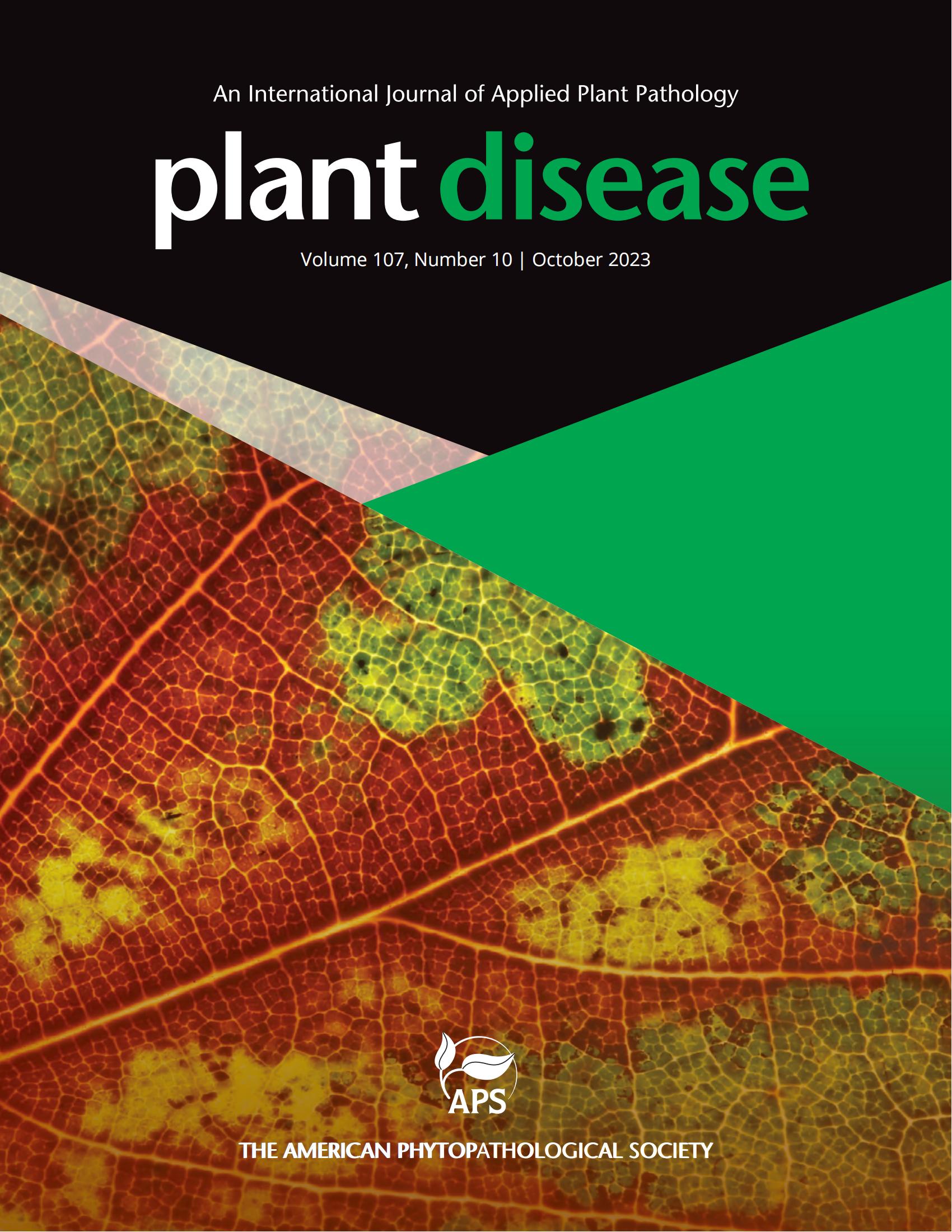加拿大首次报告在豌豆和鹰嘴豆中发现豆叶卷叶病毒。
摘要
豆类卷叶病毒(BLRV;Bean leafroll virus)是一种单链 RNA 病毒,属于 Luteovirus 属,具有韧皮部局限性,主要通过蚜虫以非繁殖、持久的方式传播(Rashed 等人,2018 年;Kidanemariam 和 Abraham,2023 年)。BLRV 可感染多种豆科植物,全球主要豆类种植区均有报道(Agindotan 等人,2019 年),但加拿大草原地区没有报道。它对作物产量的影响因植物和病毒基因型以及感染时间而异。一些豌豆田的发病率高达 80%(克莱门特等人,2020 年;汉普顿,1983 年)。在 2022 年的整个生长季节(6 月和 7 月),随机选择并调查了萨斯喀彻温省各地的豌豆田,收集叶片黄化和萎蔫的有症状植株,并在处理前保存在 -80°C 温度下。观察到的症状包括豌豆的坏死斑、萎黄病、叶片斑驳、卷叶,鹰嘴豆的严重亮黄和叶片边缘坏死。使用酶联免疫吸附试验(ELISA)和反转录聚合酶链反应(RT-PCR)对采集的 35 份样本叶片进行了 BLRV 检测。酶联免疫吸附试验(ELISA)按照生产商提供的方案使用商业试剂盒(Nano Diagnostics, San Jose, CA, USA)进行。使用 TRIzol(Invitrogen,Carlsbad,CA,USA)从冷冻样本中提取总 RNA。为了检测不同的 BLRV 分离物,对不同分离物的序列进行了比对,并在内部专门设计了针对 GP3 和 3' UTR 上病毒高度保守区的引物(见补充材料)。另外还设计了针对衣壳蛋白(CP)编码区的引物,这些引物以前曾用于检测 BLRV(Agindotan 等,2019 年;Larsen & Webster,1999 年)。对包括 12 株豌豆植株和 23 株鹰嘴豆植株在内的 35 份有症状样本进行 PCR 检测,发现两份有症状样本中存在 BLRV,其中一份分别来自大田豌豆(Pisum sativum L. var. CDC Inca),另一份来自沙漠型鹰嘴豆(Cicer arietinum L. var. CDC Leader)。受感染的豌豆和鹰嘴豆样本分别位于萨斯喀彻温省的萨斯卡通(坐标:北纬 52°9'27'',西经 106°34'14")和萨斯喀彻温省西南部的利德地区(坐标:北纬 50°52'14",西经 109°23'11")。PCR 扩增子经纯化后送去进行 Sanger 测序。读数经组装后分别产生了来自豌豆和鹰嘴豆的 1666 和 323 个核苷酸,覆盖率至少为 2 倍。从豌豆(PsSK1)和鹰嘴豆(CaSK1)获得的 BLRV 分离物的部分核苷酸序列(GenBank 编号:PP240429、PP266588)显示(1521/1574 bp)96.63% 和(316/323 bp)97.与 BLRV 参考分离序列(NC_003369)的相似度为 83%,与来自阿根廷的分离序列(KR261610)的相似度为 98.79%(1555/1574 bp)和 98.76%(319/323 bp)。通过酶联免疫吸附试验(ELISA),两种感染样品均被确认为受 BLRV 感染,并且与阳性对照(0.292)相比,30 分钟后在 450 纳米波长下测量的相互作用比(PsSK1:0.319 和 CsSK1:0.245)较高。这是加拿大大草原脉冲种植区首次报告 BLRV。在萨斯喀彻温省,尽管种植易感作物的面积很大,但却没有出现 BLRV 的历史。因此,本研究作为调查项目的一部分,并不是为了评估 BLRV 的严重程度,而是为了确定是否存在任何可能被忽视的病毒。因此,样本是随机抽取的,重点是田块数量和地理覆盖范围,而不是每块田块上的多株植物。此外,田块也不是根据症状选择的,而是随机选择的。不过,选择田间的植物是因为它们出现了症状。通常情况下,病害说明包括对严重程度和潜在风险的估计;但本研究无法做到这一点。相反,由于假定 BLRV 不存在,因此检测到 BLRV 表明风险比以前认为的要大。这些发现突出表明,有必要进一步研究该病毒的现状、其对作物生产的影响以及萨斯喀彻温省种植的脉冲品种的抗性。Bean leafroll virus (BLRV; Bean leafroll virus), a single-stranded RNA virus in the genus Luteovirus, is phloem-limited and primarily transmitted by aphids in a non-propagative, persistent manner (Rashed et al., 2018; Kidanemariam and Abraham, 2023). BLRV infects various legumes and has been reported from major pulse-growing regions worldwide (Agindotan et al., 2019) but not in the Canadian Prairies. Its impact on crop yield varies with plant and virus genotypes and the timing of infection. Some pea fields have experienced disease rates of up to 80% (Clement et al., 2020; Hampton, 1983). Throughout the 2022 growing season (June and July), pulse fields from across Saskatchewan were randomly selected and surveyed, and symptomatic plants demonstrating leaf yellowing and chlorosis were collected and stored at -80°C before processing. Observed symptoms included necrotic spots, chlorosis, leaf mottling, leaf rolling in peas, severe bright yellowing, and leaf marginal necrosis in chickpeas. BLRV detection was performed on 35 leaves of the collected samples using both Enzyme-Linked Immunosorbent Assay (ELISA) and Reverse transcription polymerase chain reaction (RT-PCR). ELISA testing followed the manufacturer's protocol using a commercial kit (Nano Diagnostics, San Jose, CA, USA). Total RNAs were extracted from the frozen samples using TRIzol (Invitrogen, Carlsbad, CA, USA). For the detection of the diverse BLRV isolates, sequences of various isolates were aligned and primers were specifically designed in-house, targeting the virus's highly conserved regions on the GP3 and 3' UTR (see Supplementary material). Additional primers were also designed targeting coat protein (CP) coding regions which were previously used for BLRV detection (Agindotan et al. 2019; Larsen & Webster 1999). PCR testing of 35 symptomatic samples including 12 pea plants and 23 chickpea plants, identified the presence of BLRV in two symptomatic samples, one each from a field pea (Pisum sativum L. var. CDC Inca) and a desi-type chickpea (Cicer arietinum L. var. CDC Leader). The infected pea and chickpea samples were found in Saskatoon, SK (Coordinates: 52°9'27''N,106°34'14"W), and the Leader area, southwest of Saskatchewan, SK (Coordinates: 50°52'14"N,109°23'11"W), respectively. PCR amplicons were purified and sent for Sanger sequencing. The reads were assembled to generate 1666 and 323 nucleotides from pea and chickpea, respectively, with a minimum of 2X coverage. Partial nucleotide sequences of the BLRV isolates obtained from pea (PsSK1) and chickpea (CaSK1) (GenBank accession numbers: PP240429, PP266588) showed (1521/1574 bp) 96.63% and (316/323 bp) 97.83% similarity with a BLRV reference isolate sequence (NC_003369) and to an isolate from Argentina (KR261610) which was reported on Medicago sativa L. with (1555/1574 bp) 98.79% and (319/323 bp) 98.76% similarity, correspondingly. Both infected samples were confirmed to be BLRV-infected through the ELISA and exhibited a high interaction ratio (PsSK1: 0.319 and CsSK1: 0.245) compared to a positive control (0.292) after 30 minutes as measured at 450 nm. This is the first report of BLRV in the pulse-growing region of the Canadian Prairies. In Saskatchewan, there is no history of BLRV despite the large amount of area growing susceptible crops. Therefore, the survey project that this study was part of was not intended to evaluate the severity of BLRV but rather to determine if there is any virus present that might have been overlooked. The samples were therefore taken randomly, with a focus on the number of fields and geographic coverage rather than focusing on multiple plants per field. Moreover, fields were not chosen based on symptoms but rather at random. Although, plants within fields were chosen because they displayed symptoms. Typically, a disease note includes estimates of severity and potential risk; however, that is not possible for this study. Rather, the fact that it was detected indicates a greater risk than previously perceived, since it was assumed that BLRV was not present. These findings highlight the need for further research on the virus's current status, its impact on crop production, and the resistance of pulse varieties grown in Saskatchewan.

 求助内容:
求助内容: 应助结果提醒方式:
应助结果提醒方式:


